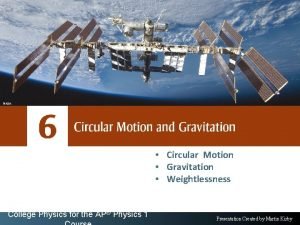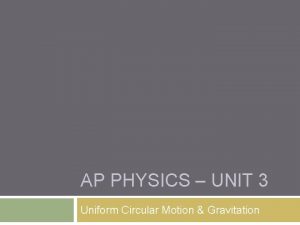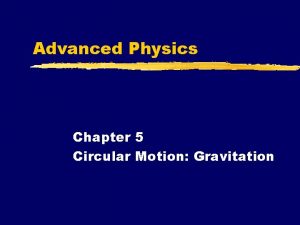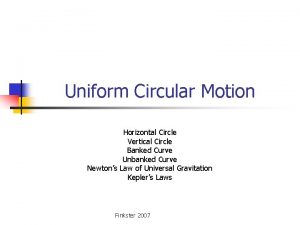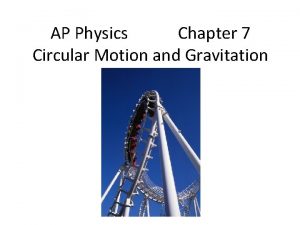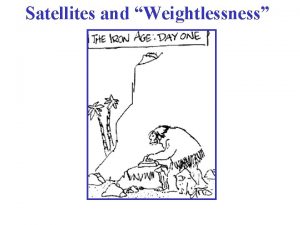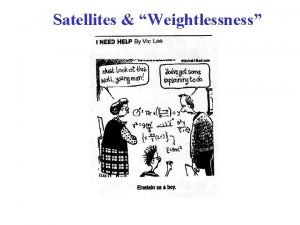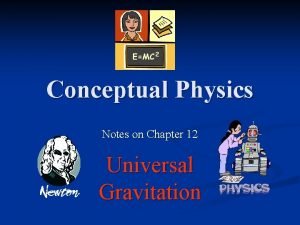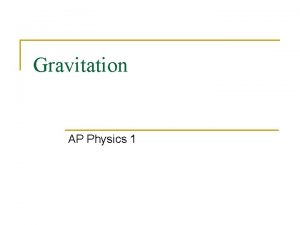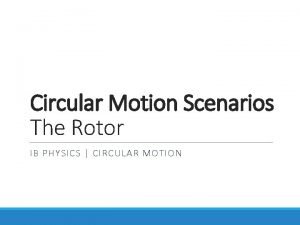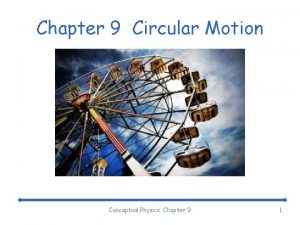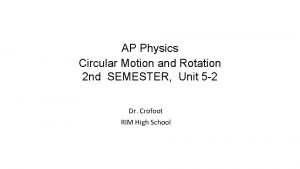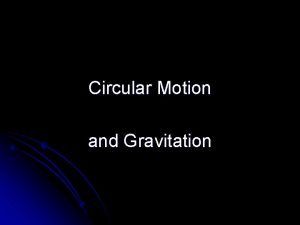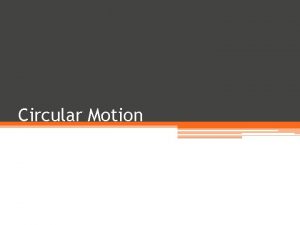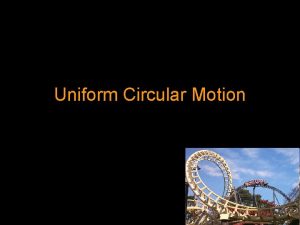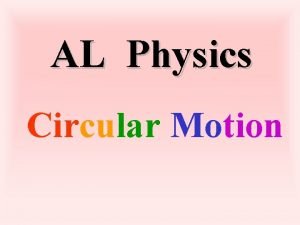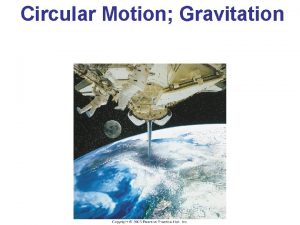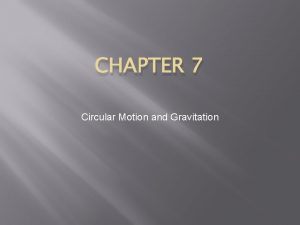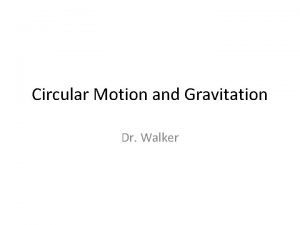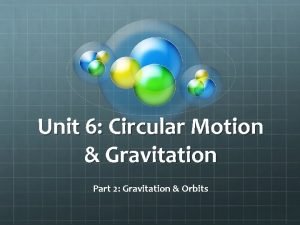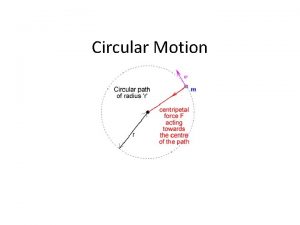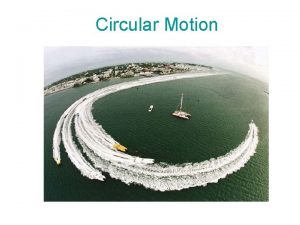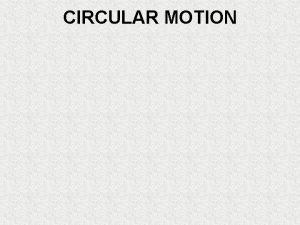NASA Circular Motion Gravitation Weightlessness College Physics for
















- Slides: 16

NASA • Circular Motion • Gravitation • Weightlessness College Physics for the AP® Physics 1 Presentation Created by Martin Kirby

Circular Motion and Uniform Circular Motion If an object is moving in a circle, we say that it has circular motion. Uniform Circular Motion If an object is moving with constant speed in a circle, we say that it has uniform circular motion. COLLEGE PHYSICS FOR THE AP® PHYSICS 1 COURSE

Uniform Circular Motion… Constant Velocity? ? ? v = 2 m/s The ball has constant speed QUESTION: Does the ball have constant velocity? Speed is a scalar quantity, so has only magnitude. Velocity is a vector quantity, so has magnitude and direction. The magnitude of the ball’s velocity is constant, but its direction is always changing. Which means that the ball’s velocity is always changing. Therefore: a ball with uniform circular motion is No…. the ball does not have always accelerating!! !! constant velocity: it’s accelerating. COLLEGE PHYSICS FOR THE AP® PHYSICS 1 COURSE

What is the direction of centripetal acceleration? Two different velocities: Same magnitudes. Different directions. The ball accelerates toward the center of the circle. COLLEGE PHYSICS FOR THE AP® PHYSICS 1 COURSE

ac = v 2/r Fc = mv 2/r Objects that have uniform circular motion accelerate toward the center of the circle. m r Centrifugal: away from the center. Centripetal: toward the center. The acceleration of the object must be caused by a net force acting in the same direction: the centripetal force. COLLEGE PHYSICS FOR THE AP® PHYSICS 1 COURSE

Centripetal force is not an extra force; it’s a sum. Fspring If an object is rotating with uniform circular motion, m Fmystery Fwind the sum of all the forces exerted on the Fmagnetism object (Fc , the centripetal force) must point toward the center of the circle. ∑F = Fc m Fc , the centripetal force, is not an extra force. It’s simply the sum of all the forces acting on the object. COLLEGE PHYSICS FOR THE AP® PHYSICS 1 COURSE

Centripetal Force: Question 1 12 kg 8. 00 r. p. m. A 12. 0 -kg child stands 2. 00 m from the center of a merry-go-round that rotates 8. 00 times per minute. Fs 12. 0 kg 2. 00 m What is the minimum µs needed to keep the child from slipping? The force ofis static friction If the child about to slip: Fs is the centripetal Fs = Fs max force. Side view COLLEGE PHYSICS FOR THE AP® PHYSICS 1 COURSE

Centripetal Force: Question 2 Determine the A small 2. 00 kg ball moves with constant speed of the ball speed in a horizontal circle of 4. 00 m 30˚ Fc r = 4. 00 m 2. 00 kg FT radius while attached to the end of string that is 30˚ to the vertical. Determine the speed of the ball There are two forces 2. 00 kg The ball is moving in a circle with constant speed, exerted on the ball: Fg so the centripetal force F : Weight g A small 2. 00 kg ball moves with (the sum of all the forces FT : Tension. constant speed in a horizontal exerted on the ball) must Note: the answer circle of 4. 00 m radius while point toward the center of would be the same for attached to the end of string the circle. any value of mass. that is 30˚ to the vertical. COLLEGE PHYSICS FOR THE AP® PHYSICS 1 COURSE

The Law of Universal Gravitation r m 1 Fg Fg m 2 The Law of Universal Gravitation Fg : Gravitational force (N) G : Universal Gravitational Constant = 6. 67 × 10– 11 Nm 2/kg 2 m 1 : mass of one sphere or point object (kg) m 2 : mass of the other sphere or point object (kg) r : distance between the center of mass of each object (m) COLLEGE PHYSICS FOR THE AP® PHYSICS 1 COURSE

The Law of Universal Gravitation: Notes r m 1 Fg Fg m 2 The Law of Universal Gravitation G has the same value everywhere in our universe: G = 6. 67 × 10– 11 Nm 2/kg 2 Every object in our universe attracts every other object in our universe. Fg on m 1 has the same magnitude as Fg on m 2. The law only applies to spherical objects or point objects. The total gravitational force exerted on an object, Fg, acts from the center of gravity. COLLEGE PHYSICS FOR THE AP® PHYSICS 1 COURSE

Fg = Gm 1 m 2/r 2 always works. m 2 Fg Fg m 1 The huge planet and the baseball are attracting each other with a force of the same size. Both objects must be accelerating toward each other (∑F = ma). The acceleration of m 1 will be very, very small compared to that of m 2. COLLEGE PHYSICS FOR THE AP® PHYSICS 1 COURSE

g : the Acceleration Due to Gravity We know that, close to Earth’s surface, g (the acceleration due to gravity), is 9. 8 m/s 2. How could the value of g be found for a greater distance from Earth? r Fg Fg m 2 m 1 g 2 COLLEGE PHYSICS FOR THE AP® PHYSICS 1 COURSE

What speed is needed to successfully orbit? For a satellite to successfully orbit a planet at a specific radius, it must have a specific speed… The centripetal force is the gravitational force… m 1 r Fg Fg m 2 v For a successful orbit at a specific radius, this specific speed is needed. Note that the mass of the satellite is irrelevant. COLLEGE PHYSICS FOR THE AP® PHYSICS 1 COURSE

How much time does one orbit take? T : period …the time taken for one complete orbit. v r m 1 Note that the mass of the satellite is irrelevant. COLLEGE PHYSICS FOR THE AP® PHYSICS 1 COURSE

Apparent Weightlessness astronaut spaceship An empty spaceship and aninside astronaut We now put the astronaut the are orbiting a planet. spaceship. The astronaut does not Their orbits haveofthe speed, touch the inside thesame spaceship. radius and period. The astronaut thinks that she is weightless because she is not falling toward the walls of the spaceship. The astronaut is not weightless… without weight (the pull of gravity), she would move in a straight line with constant velocity. COLLEGE PHYSICS FOR THE AP® PHYSICS 1 COURSE

Chapter 6 Summary The Law of Universal Gravitation If an object is moving with constant speed in a circle, then the sum of all the forces exerted on the object points toward the center of the circle. The sum is called the centripetal force, Fc. COLLEGE PHYSICS FOR THE AP® PHYSICS 1 COURSE
 Circular motion images
Circular motion images Unit 3 circular motion and gravitation
Unit 3 circular motion and gravitation Chapter 5 circular motion gravitation
Chapter 5 circular motion gravitation 3.f horizontal circles
3.f horizontal circles G force comparison
G force comparison Weightlessness definition physics
Weightlessness definition physics Weightlessness definition physics
Weightlessness definition physics Example of weightlessness
Example of weightlessness Weightlessness in satellite
Weightlessness in satellite Conceptual physics chapter 13 universal gravitation
Conceptual physics chapter 13 universal gravitation Newton's universal law of gravitation ap physics 1
Newton's universal law of gravitation ap physics 1 Rotor ride physics free body diagram
Rotor ride physics free body diagram Circular motion conceptual physics
Circular motion conceptual physics Ap physics circular motion
Ap physics circular motion Kahulugan ng awit
Kahulugan ng awit Calipso browse images
Calipso browse images Which element of hair design is used
Which element of hair design is used
